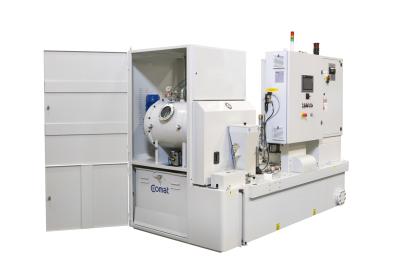
In 2016, Eriez HydroFlow partnered with Milan, Italy-based Comat S.r.l. to bring SuperFiltration technology to North America, providing customers a long-awaited solution to remove particles down to 3-micron nominal from cutting fluid while maintaining a stable fluid temperature. Eriez reports this technology is generating strong activity and a positive response from the marketplace.
Eriez HydroFlow coolant SuperFiltration systems offer an alternative to edge-type filtration in oil applications. The most common applications involve parts surface finishing, where tolerances and roughness must be strictly controlled to protect product quality.
SuperFiltration systems are mainly connected with grinders, sharpening, lapping and honing machines. They are also now commonly applied to automatic lathe units to filter oil recovered from chips centrifugation, from the periodic emptying of the tanks and for the oil used at high pressure for the drilling process.
“With thousands of machine tools worldwide operating with our technology, these systems are superfiltering 530,000 US gallons of metalworking oil every minute for leading manufacturers around the globe,” says Darrell Milton, manager-filtration systems. “We are observing an escalation in the demand for these systems and anticipate continued growth in this area.”
Customers can use their PC, tablet or smartphone to remotely monitor, manage and adjust their SuperFiltration System to match a machine tool's daily working conditions.
Contact Details
Related Glossary Terms
- coolant
coolant
Fluid that reduces temperature buildup at the tool/workpiece interface during machining. Normally takes the form of a liquid such as soluble or chemical mixtures (semisynthetic, synthetic) but can be pressurized air or other gas. Because of water’s ability to absorb great quantities of heat, it is widely used as a coolant and vehicle for various cutting compounds, with the water-to-compound ratio varying with the machining task. See cutting fluid; semisynthetic cutting fluid; soluble-oil cutting fluid; synthetic cutting fluid.
- cutting fluid
cutting fluid
Liquid used to improve workpiece machinability, enhance tool life, flush out chips and machining debris, and cool the workpiece and tool. Three basic types are: straight oils; soluble oils, which emulsify in water; and synthetic fluids, which are water-based chemical solutions having no oil. See coolant; semisynthetic cutting fluid; soluble-oil cutting fluid; synthetic cutting fluid.
- lapping
lapping
Finishing operation in which a loose, fine-grain abrasive in a liquid medium abrades material. Extremely accurate process that corrects minor shape imperfections, refines surface finishes and produces a close fit between mating surfaces.
- lathe
lathe
Turning machine capable of sawing, milling, grinding, gear-cutting, drilling, reaming, boring, threading, facing, chamfering, grooving, knurling, spinning, parting, necking, taper-cutting, and cam- and eccentric-cutting, as well as step- and straight-turning. Comes in a variety of forms, ranging from manual to semiautomatic to fully automatic, with major types being engine lathes, turning and contouring lathes, turret lathes and numerical-control lathes. The engine lathe consists of a headstock and spindle, tailstock, bed, carriage (complete with apron) and cross slides. Features include gear- (speed) and feed-selector levers, toolpost, compound rest, lead screw and reversing lead screw, threading dial and rapid-traverse lever. Special lathe types include through-the-spindle, camshaft and crankshaft, brake drum and rotor, spinning and gun-barrel machines. Toolroom and bench lathes are used for precision work; the former for tool-and-die work and similar tasks, the latter for small workpieces (instruments, watches), normally without a power feed. Models are typically designated according to their “swing,” or the largest-diameter workpiece that can be rotated; bed length, or the distance between centers; and horsepower generated. See turning machine.
- metalworking
metalworking
Any manufacturing process in which metal is processed or machined such that the workpiece is given a new shape. Broadly defined, the term includes processes such as design and layout, heat-treating, material handling and inspection.

